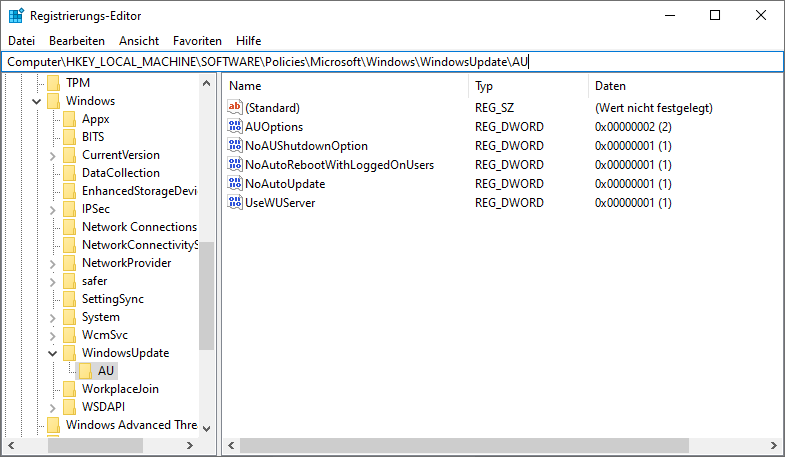Check registry entries from CAWUM
Initial situation
As soon as a client is managed in Windows Update Management via managed by WUM, ACMP automatically sets the registry entries required on the client. This should overwrite prior entries and prevent them from actively interfering with the process. If problems arise, it is still advisable to check the registry entries once.
Procedure
First, ensure that the clients are actually listed in the managed by WUM tab and that they are managed via ACMP. Now open the Registry Editor (Win key + R > ‘regedit’). Navigate to the relevant sections to check the registry values, because as soon as a client is listed there, the following registry keys should be automatically stored for it:
[HKEY_LOCAL_MACHINE\SOFTWARE\Policies\Microsoft\Windows\WindowsUpdate]
"WUServer"="https://127.0.0.1:8530"
"WUStatusServer"="https://127.0.0.1:8530"
"UpdateServiceUrlAlternate"="https://127.0.0.1:8530"
"DisableDualScan"=dword:00000001
[HKEY_LOCAL_MACHINE\SOFTWARE\Policies\Microsoft\Windows\WindowsUpdate\AU]
"NoAutoUpdate"=dword:00000001
"NoAUShutdownOption"=dword:00000001
"AUOptions"=dword:00000002
"UseWUServer"=dword:00000001
"NoAutoRebootWithLoggedOnUsers"=dword:00000001

View of the opend Registry Editor
If you still have GPOs active that affect these values or have other values in the path [HKEY_LOCAL_MACHINE\SOFTWARE\Policies\Microsoft\Windows\WindowsUpdate], please disable them.
A simple method to determine this is as follows:
First, exit the ACMP Client service on the affected device and then delete the registry key [HKEY_LOCAL_MACHINE\SOFTWARE\Policies\Microsoft\Windows\WindowsUpdate].
Then execute a GPUpdate /force in an administrative CMD and check whether [HKEY_LOCAL_MACHINE\SOFTWARE\Policies\Microsoft\Windows\WindowsUpdate] has been recreated.
If this is the case, please determine the GPOs and disable them.
If, after deletion and a GPUpdate /force, the key [HKEY_LOCAL_MACHINE\SOFTWARE\Policies\Microsoft\Windows\WindowsUpdate] is no longer created, you can restart the ACMP client service and execute a Windows Update scanner again after deleting the local Windows Update cache.
Then restart the ACMP client service.


